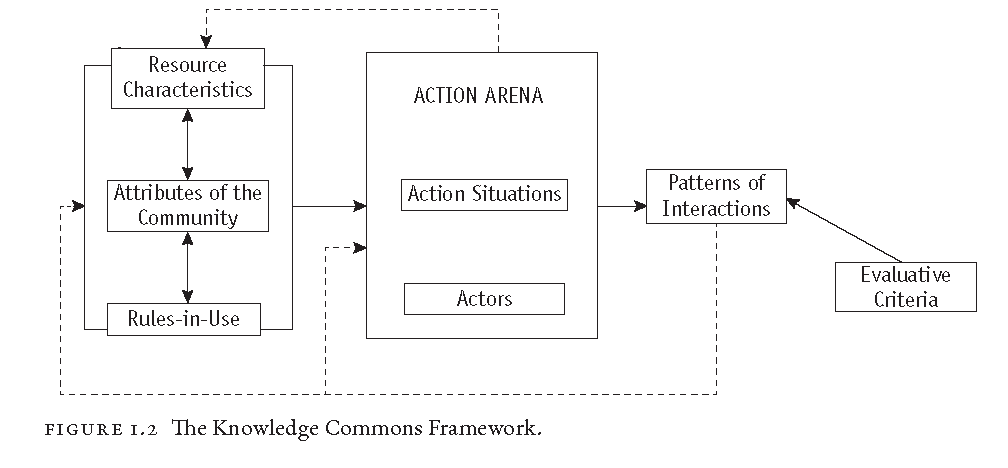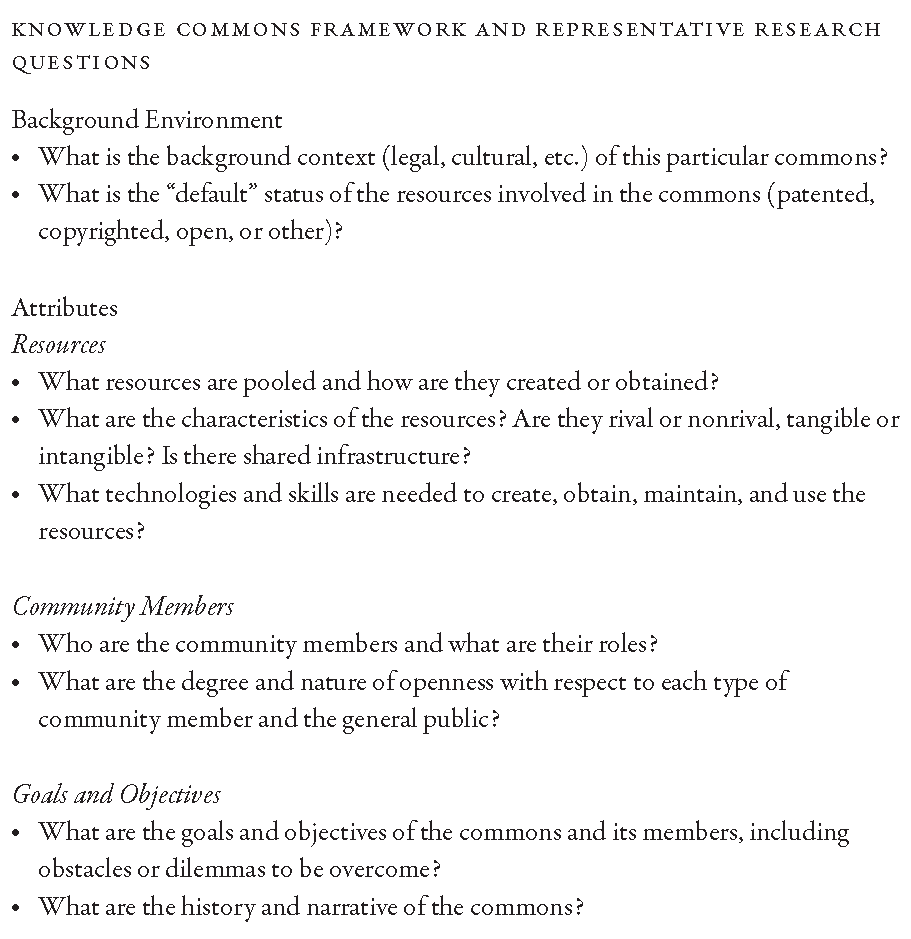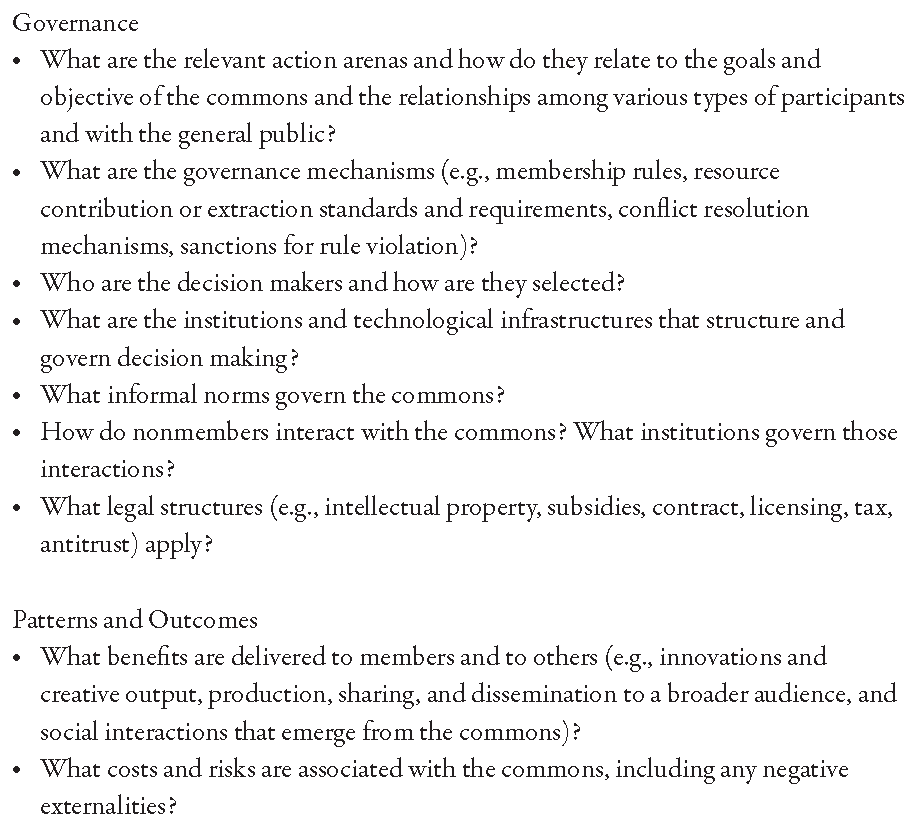The following offers a brief introduction to the knowledge commons research framework that is described and applied in Governing Knowledge Commons (Frischmann, Madison, & Strandburg eds., Oxford University Press 2014). The framework is multidisciplinary by design. It may be used together with methods specific to law, political science, economics, sociology, and history, among other fields.
A schematic of the framework:

Source: “Governing Knowledge Commons,” in Governing Knowledge Commons (Frischmann, Madison, & Strandburg eds., Oxford University Press 2014) at 19; originally published in Michael J. Madison, Brett M. Frischmann, and Katherine J. Strandburg. 2010. “Constructing Commons in the Cultural Environment.” Cornell Law Review. 95(4): 657-709. Adapted from Elinor Ostrom, Understanding Institutional Diversity (Princeton University Press 2005).
Using the framework to build a case study involves organizing clusters of research questions that are linked to the elements of the schematic, as follows:
Source: “Governing Knowledge Commons,” in Governing Knowledge Commons (Frischmann, Madison, & Strandburg eds., Oxford University Press 2014) at 20, 21.
NEW: An amended application of the GKC schematic follows, based on recent research. These constitute “Representative Research Questions”:
Background Environment
- What is the background context (legal, cultural, etc.) of this particular commons?
- What normative values are relevant for this community?
- What is the “default” status of the resources involved in the commons (patented, copyrighted, open, or other)?
- How does this community fit into a larger context? What relevant domains overlap in this context?
Attributes
Resources
- What resources are pooled and how are they created or obtained?
- What are the characteristics of the resources? Are they rival or nonrival, tangible or intangible? Is there shared infrastructure?
- What is personal information relative to resources in this action arena?
- What technologies and skills are needed to create, obtain, maintain, and use the resources?
- What are considered to be appropriate resource flows? How is appropriateness of resource use structured or protected?
Community Members
- Who are the community members and what are their roles?
- What are the degree and nature of openness with respect to each type of community member and the general public?
- What noncommunity members are impacted?
Goals and Objectives
- What are the goals and objectives of the commons and its members, including obstacles or dilemmas to be overcome?
- Who determines goals and objectives?
- What values are reflected in goals and objectives?
- What are the history and narrative of the commons?
- What is the value of knowledge production in this context?
Governance
Context
- What are the relevant action arenas and how do they relate to the goals and objective of the commons and the relationships among various types of participants and with the general public?
- Are action arenas perceived to be legitimate?
Institutions
- What legal structures (e.g., intellectual property, subsidies, contract, licensing, tax, antitrust) apply?
- What are the governance mechanisms (e.g., membership rules, resource contribution or extraction standards and requirements, conflict resolution mechanisms, sanctions for rule violation)?
- What are the institutions and technological infrastructures that structure and govern decision making?
- What informal norms govern the commons?
- What institutions are perceived to be legitimate? Illegitimate? How are institutional illegitimacies addressed?
Actors
- Who are the decision makers and how are they selected? Are decision-makers perceived to be legitimate?
- How do nonmembers interact with the commons? What institutions govern those interactions?
- Are there impacted groups that have no say in governance?
Patterns and Outcomes
- What benefits are delivered to members and to others (e.g., innovations and creative output, production, sharing, and dissemination to a broader audience, and social interactions that emerge from the commons)?
- What costs and risks are associated with the commons, including any negative externalities?
- Are outcomes perceived to be legitimate by members? By decision-makers? By impacted outsiders?
Source: Sanfilippo, M., Frischmann, B., & Standburg, K. (2018). Privacy as Commons: Case Evaluation Through the Governing Knowledge Commons Framework. Journal of Information Policy, 8, 116-166. https://doi.org/10.5325/jinfopoli.8.2018.0116


Pingback: Sustainable community building with the Wikibase Stakeholder Group – presentation at FOSDEM 2022 - TIB-Blog
Pingback: Report (part 1) of workshop “Data Commons for smart cities” – Michiel de Lange
Comments are closed.